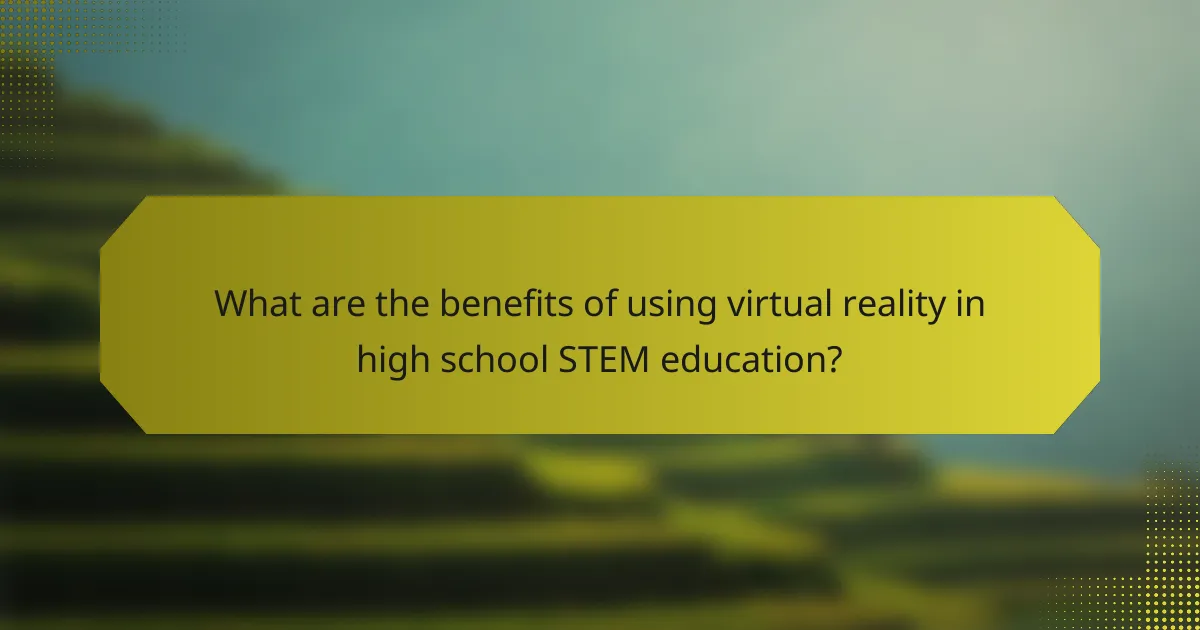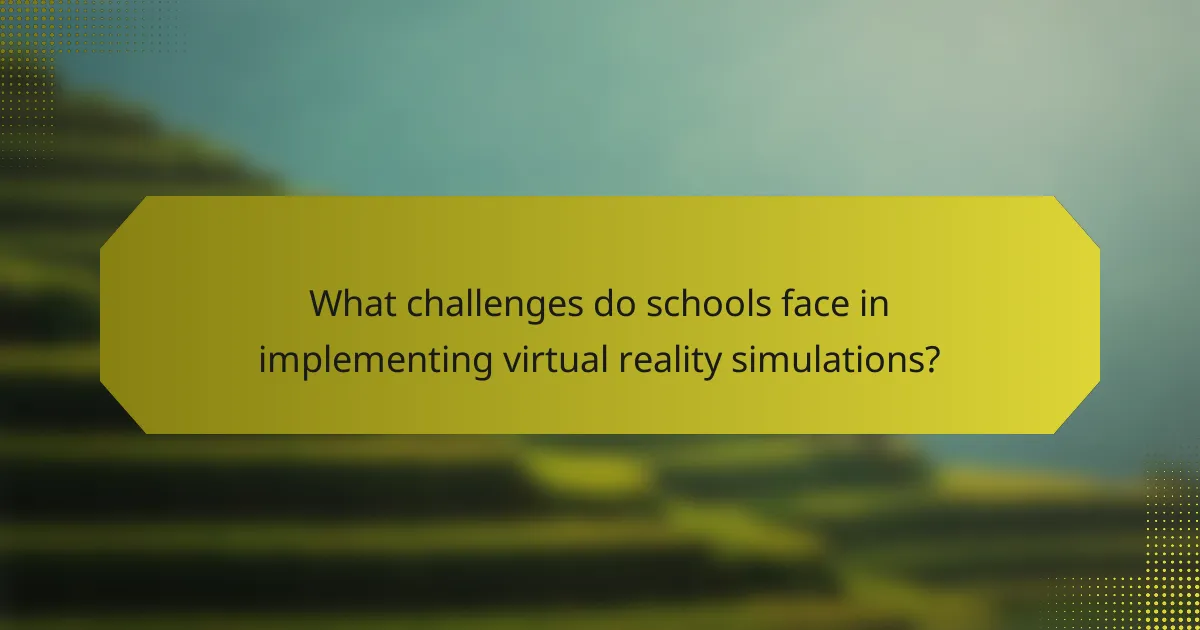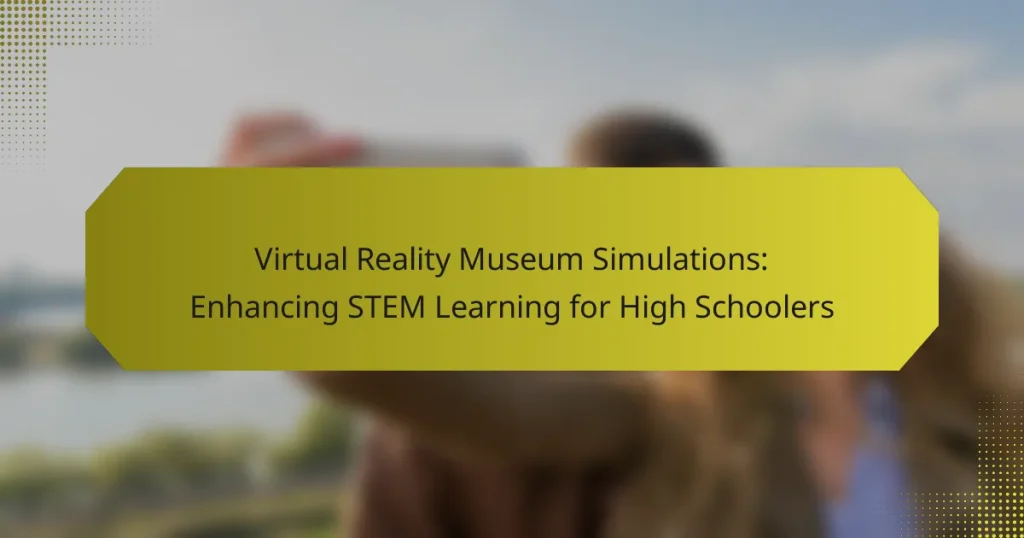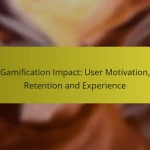Virtual reality museum simulations are revolutionizing STEM education for high school students by creating immersive and interactive environments that captivate learners. These innovative tools enable students to engage with complex scientific concepts in a hands-on manner, significantly enhancing their understanding and retention of the material.

How do virtual reality museum simulations enhance STEM learning for high schoolers?
Virtual reality museum simulations significantly enhance STEM learning for high schoolers by providing immersive and interactive environments that engage students in scientific concepts. These simulations allow learners to explore complex topics in a hands-on manner, fostering deeper understanding and retention of material.
Immersive learning experiences
Immersive learning experiences in virtual reality (VR) create a sense of presence that traditional classrooms often lack. Students can virtually walk through historical sites, explore the human body, or interact with scientific phenomena, making abstract concepts more tangible. This level of engagement can lead to increased motivation and enthusiasm for STEM subjects.
For example, a VR simulation of a space mission allows students to experience the challenges of space travel firsthand, enhancing their understanding of physics and engineering principles. Such experiences can be more impactful than textbook learning, as they stimulate curiosity and encourage exploration.
Interactive engagement with scientific concepts
Interactive engagement is a key feature of VR simulations, allowing students to manipulate variables and see real-time results. This hands-on approach helps learners grasp complex scientific concepts by providing immediate feedback and fostering critical thinking skills. For instance, students can conduct virtual chemistry experiments without the risks associated with real-life labs.
Additionally, VR platforms often include quizzes and challenges that test students’ knowledge as they progress through simulations. This gamified learning approach not only reinforces concepts but also makes learning enjoyable and competitive.
Real-world applications of STEM
Virtual reality museum simulations bridge the gap between theoretical knowledge and real-world applications of STEM. By experiencing scenarios that professionals encounter, students can better understand how STEM fields operate in practice. For example, a simulation that replicates an engineering project teaches students about project management, teamwork, and problem-solving.
Furthermore, these simulations can introduce students to various career paths in STEM, showcasing the relevance of their studies. By interacting with virtual professionals and engaging in realistic tasks, students can envision their future roles in science, technology, engineering, and mathematics, making their education more purposeful.

What are the best virtual reality museum simulations for STEM education?
The best virtual reality museum simulations for STEM education provide immersive experiences that enhance learning through interactive exhibits and engaging content. These simulations allow high school students to explore complex scientific concepts and historical contexts in a visually stimulating environment.
Google Arts & Culture
Google Arts & Culture offers a vast collection of virtual museum tours and interactive exhibits that cover a wide range of STEM topics. Students can explore everything from the intricacies of human anatomy to the wonders of space through high-quality visuals and informative narratives.
This platform is accessible on various devices, making it easy for educators to integrate it into their curriculum. Teachers can assign specific tours or let students choose their own adventures, fostering independent learning and curiosity.
Curatours
Curatours provides a unique platform for virtual museum experiences, focusing on interactive storytelling and guided tours. It allows students to engage with exhibits in a way that promotes critical thinking and discussion, making it an excellent tool for STEM education.
With its user-friendly interface, Curatours enables educators to create custom tours tailored to their lesson plans. This flexibility allows for deeper exploration of specific STEM subjects, enhancing the overall educational experience.
Virtual Reality Museum of Fine Arts
The Virtual Reality Museum of Fine Arts combines art with science, offering students insights into the intersection of these fields. Through virtual exhibits, students can analyze artistic techniques while learning about the scientific principles behind them, such as color theory and perspective.
This simulation encourages students to think critically about both art and science, making connections that enrich their understanding of both disciplines. It is particularly useful for interdisciplinary projects that require collaboration between STEM and arts education.

How can educators integrate virtual reality into STEM curricula?
Educators can effectively integrate virtual reality (VR) into STEM curricula by aligning VR experiences with learning objectives, providing adequate training for teachers, and implementing suitable assessment methods. This approach enhances engagement and understanding of complex concepts in science, technology, engineering, and mathematics.
Curriculum alignment strategies
To align VR with the STEM curriculum, educators should identify specific learning outcomes that VR can support. For instance, using VR simulations to visualize chemical reactions or engineering designs can deepen students’ comprehension. It’s essential to ensure that VR content complements existing lesson plans rather than replacing them.
Collaboration with curriculum developers can help create VR modules that meet educational standards. Educators should consider integrating VR experiences at key points in the curriculum, such as during project-based learning or when introducing new concepts, to maximize their impact.
Technology training for teachers
Providing technology training for teachers is crucial for successful VR integration. Educators should receive hands-on training to familiarize themselves with VR tools and software, enabling them to guide students effectively. Workshops and ongoing professional development can help teachers stay updated on the latest VR technologies and teaching strategies.
Peer mentoring can also be beneficial, allowing experienced teachers to share insights and best practices with colleagues. Schools should allocate time for teachers to experiment with VR applications, fostering confidence in using this technology in the classroom.
Assessment methods for VR learning
Assessing student learning in VR environments requires innovative methods that go beyond traditional testing. Educators can use formative assessments, such as observation and feedback during VR activities, to gauge student engagement and understanding. Additionally, incorporating reflective journals where students document their experiences can provide valuable insights into their learning processes.
Summative assessments can include projects or presentations based on VR simulations, allowing students to demonstrate their knowledge and skills. It’s important to develop clear rubrics that align with learning objectives to ensure fair evaluation of student performance in VR settings.

What are the benefits of using virtual reality in high school STEM education?
Virtual reality (VR) in high school STEM education offers immersive experiences that enhance learning engagement and understanding. By simulating real-world scenarios, VR helps students grasp complex concepts more effectively than traditional methods.
Increased student motivation
Virtual reality captures students’ attention and fosters a sense of excitement about learning. Engaging environments and interactive simulations can transform mundane subjects into captivating experiences, motivating students to participate actively in their education.
For instance, a VR simulation of a space mission can inspire students to explore physics and engineering concepts. This hands-on approach often leads to higher attendance and participation rates in STEM classes.
Enhanced retention of information
Students exposed to VR experiences tend to retain information better than those who learn through conventional methods. The immersive nature of VR allows learners to visualize and interact with concepts, reinforcing their understanding and memory.
Research suggests that experiential learning, such as VR simulations, can improve retention rates significantly. For example, students who engage in a virtual biology lab may recall information about cellular processes more effectively than if they had only read about them in a textbook.
Development of critical thinking skills
Virtual reality encourages students to solve problems and make decisions in realistic scenarios, fostering critical thinking skills. As they navigate challenges in a simulated environment, learners develop analytical abilities and learn to apply theoretical knowledge to practical situations.
For example, a VR simulation that requires students to design a sustainable city can enhance their understanding of environmental science while promoting teamwork and innovative thinking. This hands-on experience prepares them for real-world challenges in STEM fields.

What challenges do schools face in implementing virtual reality simulations?
Schools encounter several challenges when implementing virtual reality (VR) simulations, including budget constraints and access to technology. These obstacles can hinder the effective integration of VR into STEM education, limiting the potential benefits for high school students.
Budget constraints
Many schools operate under tight budgets, making it difficult to allocate funds for VR technology. The cost of VR headsets, software licenses, and necessary hardware can quickly add up, often reaching thousands of dollars.
To address budget constraints, schools can explore grants, partnerships with tech companies, or crowdfunding initiatives. Additionally, considering low-cost or open-source VR solutions can help reduce expenses while still providing valuable learning experiences.
Access to technology
Access to the necessary technology is another significant challenge. Not all students have personal devices capable of running VR applications, and schools may lack the infrastructure to support VR setups, such as high-speed internet and adequate space.
Schools should assess their current technology capabilities and seek community partnerships to enhance access. Implementing VR in a shared environment, like a dedicated lab, can maximize resources and ensure all students have the opportunity to engage with VR simulations.


